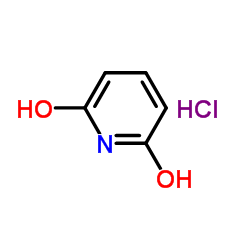2,6-pyridinediol, hydrochloride

2,6-pyridinediol, hydrochloride structure
|
Common Name | 2,6-pyridinediol, hydrochloride | ||
|---|---|---|---|---|
| CAS Number | 10357-84-3 | Molecular Weight | 147.560 | |
| Density | 1.379g/cm3 | Boiling Point | 387.2ºC at 760mmHg | |
| Molecular Formula | C5H6ClNO2 | Melting Point | 206-208 °C (dec.)(lit.) | |
| MSDS | USA | Flash Point | 188ºC | |
| Symbol |

GHS07 |
Signal Word | Warning | |
|
[Estimation of pathways of 5-fluorouracil anabolism in human cancer cells in vitro and in vivo].
Gan To Kagaku Ryoho. 23(6) , 721-31, (1996) Possible pathways of intracellular phosphorylation of 5-fluorouracil (5-FU) in human cancer cells were investigated in vitro and in vivo. We used two inhibitors which regulate the anabolism of 5-FU for the purpose of elucidation of its pathways; one is oxonic... |
|
|
An alpha/beta-fold C--C bond hydrolase is involved in a central step of nicotine catabolism by Arthrobacter nicotinovorans.
J. Bacteriol. 187(24) , 8516-9, (2005) The enzyme catalyzing the hydrolytic cleavage of 2,6-dihydroxypseudooxynicotine to 2,6-dihydroxypyridine and gamma-N-methylaminobutyrate was found to be encoded on pAO1 of Arthrobacter nicotinovorans. The new enzyme answers an old question about nicotine cata... |
|
|
Combination of the chemotherapeutic agent 5-fluorouracil with an inhibitor of its catabolism results in increased micronucleus induction.
Biochem. Biophys. Res. Commun. 203(2) , 1124-30, (1994) The rate limiting step in 5-fluorouracil catabolism is catalyzed by the enzyme dihydropyrimidine dehydrogenase. Since degradation of 5-fluorouracil decreases its efficacy in chemotherapy, the inhibition of its catabolism is a promising tool. We investigated t... |